Physical literacy enriched school transportation
A pilot project that aims to change behaviours and attitudes and promote more active ways for children to get to and from school.
Just as our children have the opportunity to learn to read, write and count, they must also get the chance to develop competence and confidence to move in order to be more physically active, which is necessary for living a longer, healthy life.
One step towards this goal is to change the way children get themselves to school and turn it into an experience filled with positive challenges. We’re calling it the ‘It’s Cool to get to School’ project, as we believe every child should be able to develop their motivation, ability and opportunities to be more active on their journey to and from school.
During the spring and autumn of this year the project was implemented at Ersdungens elementary school in Umeå. Children and teachers from several classes came up with different ways to get more active on their journey to and from school. And now, with the summer break behind us, they’ll be putting their ideas into practice for a few weeks. The hope is that their suggestions, which all promote and improve physical literacy, will generate lots of positive experiences and that lessons will be learnt that will convince more classes in schools in and around Umeå to choose active transports to school!
Physical Literacy Instructor Wictor Lundström is in charge of coordinating the pilot project and will lead the work of developing and implementing different ways of getting active while getting to school.
This project is made possible thanks to the support of Bostaden (Umeå municipality’s public housing company), which joins us as project partners.
“We want to help Umeå develop as an active society and we hope that the lessons learnt from this project will benefit more schools in its next phase. We’re also keen to learn more about the social innovations physical literacy helps create in order to be able to develop parts of our own business”, says Anders Hugosson, Marketing Manager at Bostaden.
Summary of the project
The project was implemented in a collaboration between Change the game, Bostaden and Umeå municipality’s school Ersdungen. The aim was to find new forms of how children get to and from school in a physical literacy enriched way to promote sustainable development on many levels. The concept of physical literacy has been used as a compass in both the design of the project as a whole and the transport routes themselves. The pilot project wanted to review attitudes and behaviors and have a vision to use the lessons learned in the development of other initiatives in several operations. Eight different units of movement were used to and from the school based on workshops with teachers and students. The experience of the project was good for the end users and seems to have contributed to changed attitudes and self-confidence related to physical literacy. The results of the pilot project hope to create a forum for change and innovation in future social developments, where many administrations and sectors work together for physical literacy communities.
The project made it clear that current recommendations for playground equipment limit the possibility of creating environments that develop physical literacy. The project shows that there is a clear need for further dialogue with the relevant sectors / actors from the perspectives “as safe as possible” or “as safe as necessary”.
From a broad perspective, the pilot project lived up to the goals set and plans for further development and collaboration in several sectors will be discussed.
Read more about our partner Bostaden here >
Discover more about physical literacy here >
Q&As about the project
What is the purpose of the project?
The project is designed to help develop Umeå as an active society by encouraging children and young adults to engage in healthier ways of getting to and from school and contributing to a better Umeå!
What is the goal of the project?
The goal is to learn lessons that can be shared with more schools in Umeå as well as other schools throughout the country. We want to understand more about how physical literacy can be introduced into various businesses and environments in the future, as well as discover new ways to promote physical literacy within the school curriculum.
Can I be a part of the project?
Yes! You can encourage the children and young people around you to get involved. If you usually take your children to school by car think about leaving it at home and motivate your children to take part in the ‘It’s Cool to Get to School’ project instead (and accompany them on their journey too!) Surveys and interviews will be conducted with focus groups in order to gather the experiences and feedback of participants. We’d really appreciate you getting involved if you receive a request to participate in a survey or focus group.
What is physical literacy?
We know that children need to learn how to read and write. We also now know that children need to learn how to become more physically active. By giving children the right tools and techniques we can help them develop what we call their physical alphabet, which in turn encourages them to be more active. However, being active isn’t necessarily the same thing as being healthy. It’s more about learning how to activate our bodies in various ways. Physical literacy can be compared to a person’s vocabulary – the more movements you know the bigger your physical vocabulary will become!
Why do we call it ‘physical literacy’?
The international expression ‘physical literacy’ sounds a little strange when translated into Swedish, which is why we’ve interpreted it as ‘rörelserikedom’, which we feel projects a more positive message. The Swedish Sports Confederation sometimes calls it ‘rörelseförståelse’ (‘understanding of movement’ in English).
Shouldn’t all children be active anyway?
Yes, but not all children are. Today only 44 percent of boys and 22 percent of girls reach the recommended level of one hour of physical activity per day*. There are several reasons why children aren’t moving enough, but one of the most important ones is that if children don’t know how to be active it’s very easy for them not to get moving. We want to change that.
Why is some of this project quite challenging?
These days we know that exciting and challenging play promotes self-confidence, improves a person’s ability to cope with adversity and helps the brain remember and learn (so-called cognitive skills). It is good for us to behave like curious children and dare to try new things! To get the very best results some of the techniques recommended in the ‘It’s Cool to Get to School’ project might prove a bit challenging for some children, who may have to attempt them several times before they can progress to the next activity. Or maybe they can be creative and figure out their own way of getting more active. Remember there is no right or wrong way to use the tools and techniques we recommend!
What happens if a child hurts themselves while taking part?
All activities recommended by the ‘It’s Cool to Get to School’ project are conducted at the person’s own risk – just like in a normal playground. When it comes to insurance the ‘It’s Cool to Get to School’ project does not differ from a child’s usual methods of getting to and from school. Therefore exactly the same rules apply as they do for the child’s regular journey to school. Should an accident occur on the journey it is the school’s insurance that will apply. At other times the family’s own home insurance applies, provided of course that the family has a valid home insurance policy. Change the Game does not have its own insurance policy for injuries that may occur as a result of activities recommended by the project.
What happens if a recommended activity or technique doesn’t work?
Suggested activities and techniques are not tried and tested in the same way as activities in a playground often are, but will be continuously checked by Change the Game’s own staff and replaced or removed if they are deemed ineffectual or perceived as harmful to children. If you are concerned about a particular activity please contact Wiktor Lundström at Change the Game on 073-508 60 66.
Why is a public housing company part of the ‘It’s Cool to Get to School’ project?
For public housing company Bostaden this project is fully in line with its ambition to create sustainable homes for everyone living in Umeå. ‘It’s Cool to Get to School’ focuses on finding out more about ways to physically activate people and create socially sustainable and inclusive communities. As a non-profit public housing company Bostaden works actively with sustainability and supports projects where it can make a big difference. ‘It’s Cool to Get to School’ is one such project.
Isn’t it just a waste of resources to recommend lots of activities?
We are always conscious of recycling as much as possible when we create techniques and tools for getting people more active. These will, as far as possible, continue to be used in, for example, school playgrounds or recycled when the project is completed in a month.
How long with the project last?
The project will be implemented for four weeks up to and including September 23rd, 2019.
* These figures are taken from a national study using activities measured by the Swedish Research Council for Sports Science and published in May 2017.
For more information about this project please contact:
Wiktor Lundstöm, Physical Literacy Instructor at Change the Game, +46 73 508 60 66 or via email to wictorlundstrom@gmail.com
or
Tom Englén, Project manager / Physical Literacy Coordinator at Change the game, +46 90 138128 or tom@heja.se



